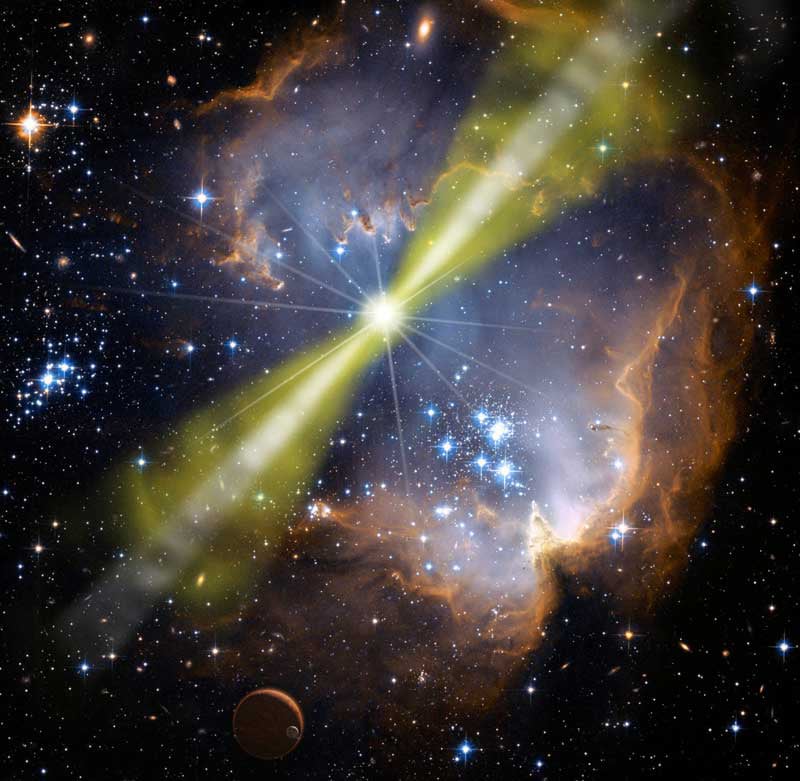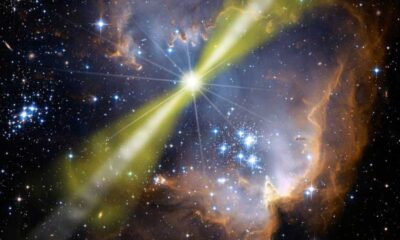Science
Powerful Gamma Ray Burst Offers Insight into Cosmic Jets

In October 2022, the astronomical community witnessed an unprecedented event with the detection of the most powerful gamma ray burst ever recorded, known as GRB 221009A. This extraordinary explosion, referred to as the “Brightest Of All Time” (BOAT), was so intense that it overwhelmed multiple instruments designed for studying such cosmic phenomena. Recent observations are now providing critical insights into the mechanisms behind gamma ray bursts, one of the universe’s most enigmatic occurrences.
Gamma ray bursts are massive explosions that release more energy in mere seconds than the Sun will emit over its entire lifespan of approximately 10 billion years. These flashes typically occur when a massive star collapses into a black hole or during the collision of neutron stars. The initial burst lasts only seconds to minutes, followed by a fading afterglow that can persist for hours to months. Despite their brilliance, studying gamma ray bursts is challenging due to their extreme distance—often billions of light years away—and the weakening of gamma rays during their journey to Earth.
Swift Observations Capture Afterglow
The swift response of the Swift satellite allowed astronomers to capture the afterglow of GRB 221009A approximately one hour after its initial detection. The resulting images displayed bright rings formed from X-rays scattered by dust layers in our galaxy, aligning with the direction of the burst. This capability emphasizes the importance of timely observations in unraveling the complexities of such cosmic events.
Following the initial detection, the Large Sized Telescope (LST-1) in La Palma, Spain, began its observations just 1.33 days after the explosion. Over a span of 20 days, researchers collected data that revealed unexpected high-energy gamma rays emanating from the burst’s afterglow. Although this signal did not meet the formal detection criteria within scientific standards, it offered valuable insights into the structure and behavior of the burst.
This data has shifted the understanding of gamma ray bursts, supporting a more intricate model of how these explosions operate. Historically, there has been debate over whether gamma ray bursts produce simple, uniform jets of plasma or more complex structures. The findings from LST-1 suggest that GRB 221009A featured a structured jet, characterized by a narrow, ultra-fast core enveloped by a wider, slower-moving shell of material.
Innovative Techniques Enhance Observation Capabilities
The observations made by LST-1 were particularly remarkable due to the bright moonlight conditions under which the data was collected. The full Moon initially hindered other telescopes from observing the burst, but through technical advancements, the LST team was able to continue their work. This innovative observational technique opens new avenues for studying transient cosmic events, even in otherwise unfavorable lunar conditions.
The successful study of GRB 221009A marks a significant milestone in high-energy astrophysics. Researchers are now positioned to delve deeper into the inner workings of astronomical sources, enhancing our understanding of the universe’s most energetic phenomena. The findings provide a clearer picture of the complex structures involved in gamma ray bursts, paving the way for future investigations and discoveries.
The implications of these observations extend beyond mere academic interest; they may also influence the development of new technologies and methodologies in astrophysics. As scientists continue to analyze the data from GRB 221009A, the insights gained will contribute to a broader understanding of cosmic events and their underlying mechanisms.
-

 Lifestyle1 week ago
Lifestyle1 week agoBelton Family Reunites After Daughter Survives Hill Country Floods
-

 Education2 weeks ago
Education2 weeks agoWinter Park School’s Grade Drops to C, Parents Express Concerns
-

 Technology2 weeks ago
Technology2 weeks agoByteDance Ventures into Mixed Reality with New Headset Development
-

 Technology2 weeks ago
Technology2 weeks agoMeta Initiates $60B AI Data Center Expansion, Starting in Ohio
-

 Lifestyle2 weeks ago
Lifestyle2 weeks agoNew Restaurants Transform Minneapolis Dining Scene with Music and Flavor
-

 Technology6 days ago
Technology6 days agoMathieu van der Poel Withdraws from Tour de France Due to Pneumonia
-

 Technology2 weeks ago
Technology2 weeks agoGlobal Market for Air Quality Technologies to Hit $419 Billion by 2033
-

 Health2 weeks ago
Health2 weeks agoSudden Vision Loss: Warning Signs of Stroke and Dietary Solutions
-

 Technology2 weeks ago
Technology2 weeks agoAnalysts Highlight Top 5 Altcoin Presales Ahead of Market Surge
-

 Technology2 weeks ago
Technology2 weeks agoTrump Faces Internal Struggles Over Epstein Files Handling
-

 Technology2 weeks ago
Technology2 weeks agoRecovering a Suspended TikTok Account: A Step-by-Step Guide
-

 Health2 weeks ago
Health2 weeks agoBacteria Navigate Gut Risks for Nutrients, New Study Reveals













